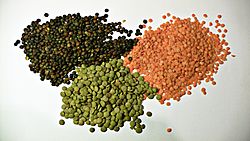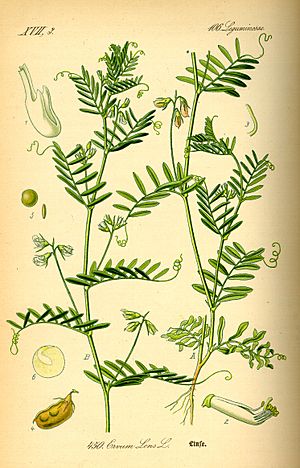Lentil facts for kids
Quick facts for kids Lentil |
|
|---|---|
 |
|
| Lentils | |
| Scientific classification | |
| Kingdom: | |
| Division: | |
| Class: | |
| Order: | |
| Family: | |
| Subfamily: | |
| Tribe: |
Vicieae
|
| Genus: | |
| Species: |
L. culinaris
|
| Binomial name | |
| Lens culinaris Medikus
|
|
The lentil (also called daal or pulse) is a small, bushy plant. It belongs to the legume family, like peas and beans. Lentils are grown for their special lens-shaped seeds. The plant usually grows to about 15 inches (38 cm) tall. Its seeds grow inside small pods, with two seeds in each pod.
Contents
Where Lentils Come From
Lentils first grew in the Middle East. They were one of the very first crops that humans started to grow on farms. People were eating lentils even before they learned how to make pottery.
Lentils are very healthy for you. They have a lot of protein, about 26%. This is one of the highest protein levels for any plant, after soybeans and hemp. Because they are so rich in protein and iron, lentils are a super important food. Many people around the world eat them often. This is especially true in India, where many people are vegetarian.
There are many different kinds of lentils. They come in various sizes, both large and small. You can find lentils in many colors too. These colors range from yellow to red-orange, green, brown, and even black.
Lentils are sold in different ways. Some have their skins on, while others have them removed. Some are whole, and some are split in half. Red, white, and yellow lentils usually have their skins taken off.
Sometimes, other foods are mistakenly called lentils. For example, a yellow "lentil" called Chana is actually made from chickpeas. Split Pigeon peas are also sometimes called lentils, but they are a different type of pulse. The urad bean is also known as a "black lentil."
Different Types of Lentils
There are many types of lentils, each with its own look and taste:
- Brown/Spanish Pardina
- French Green/Puy (These are dark speckled blue-green)
- Green (This is the most common type)
- Black/Beluga
- Yellow/Tan Lentils (These are red inside)
- Red Chief (These are yellow lentils with their skins removed)
- Eston Green (A small green type)
- Richlea (A medium green type)
- Laird (A large green type)
- Petite Golden (Lentils with their skins removed)
- Masoor (Brown-skinned lentils that are red inside)
- Pigeon Peas (A different kind of pulse, sometimes called lentils)
- Channa Dal (Made from chickpeas, not true lentils)
- Mung Lentils
- Petite Crimson/Red (Masoor lentils with their skins removed)
- Chana (These are actually kernels from chickpeas)
- Urad (A type of bean)
- White/Ivory (These are peeled Urad beans)
- Macachiados (Large Mexican yellow lentils)
How to Prepare Lentils
Lentil seeds cook very quickly. This is especially true for lentils that have had their outer skin removed, like common red lentils. Lentils have a unique, earthy flavor. They are often used to make a simple and healthy soup in Europe and North and South America. Sometimes, chicken or pork is added to the soup.
Lentils are also often cooked with rice. This works well because they have similar cooking times. In the Middle East, a dish of lentils and rice is called mujaddara or mejadra. In India, rice and lentils are cooked together in a popular dish called khichdi. Lentils are a common food throughout India, the Mediterranean regions, and the Middle East.
Many people in India are vegetarian. Lentils have been a key part of their diet for a long time, providing a good source of protein. Usually, lentils are boiled until they become a thick, stew-like consistency. Then, vegetables and a mix of spices are added. This creates many side dishes like sambar, rasam, and dal. These dishes are usually served over rice and roti (a type of flatbread).
Before cooking, lentils should be checked for any damaged pieces, small stones, or other foreign items. Then, they are rinsed under water until the water runs clear. Some people prefer to soak lentils for a longer time and then throw away the soaking water. This can help remove substances that might cause indigestion. After rinsing or soaking, the lentils are boiled in water or broth. They can be cooked on a stovetop or in a slow cooker. Pressure cookers are not usually recommended because the small lentils might block the steam release valve. Also, lentils cook so fast that a pressure cooker doesn't save much time. After cooking, lentils often need more hot water or broth added to them to reach the right thickness.
Lentils can also be sprouted, just like some beans and other edible seeds. To sprout seeds, you water and rinse them many times until they start to germinate (grow small roots and shoots). Sprouted lentils can be eaten raw, either by themselves or in salads. They can also be cooked.
Health Benefits of Lentils
Lentils are packed with good things for your body. Besides having a lot of protein, they also contain dietary fiber, vitamin B1, and important minerals. Red (or pink) lentils have less fiber than green lentils (11% compared to 31%). Health magazine even named lentils as one of the five healthiest foods! When lentils are eaten with grains like rice, they create a complete protein dish, which means they provide all the essential building blocks your body needs.
Iron Content in Lentils
Lentils give you energy from complex carbohydrates that burn slowly. They are also one of the best plant sources of iron. This makes them a very important food for vegetarians. Eating lentils can help prevent iron deficiency, which is when your body doesn't have enough iron. Iron is especially important for teenagers and pregnant women, who need more of it.
Where Lentils Are Grown
Lentils can grow well even when there isn't much rain. They are grown all over the world. About half of all the lentils produced globally come from India. Most of these are eaten within India itself. Canada is the biggest exporter of lentils in the world. The Saskatchewan region is the most important area for growing lentils in Canada. In the United States, the Palouse Region in Eastern Washington and the Idaho Panhandle is the main producing area. Its commercial center is in Moscow, Idaho.
The Food and Agriculture Organization (FAO) estimated that the world produced 3.2 million metric tons of lentils in 2003. Canada produced 520,000 metric tons that year. They likely exported 400,000 metric tons between August 2003 and July 2004. The FAO also estimated that 1.2 million metric tons of lentils were traded worldwide in 2002. Canada exported 382,000 metric tons during that year.
Lentils in Culture and History
Lentils are mentioned many times in the Old Testament, a part of the Bible. In Jewish tradition, lentils are considered a food for people who are mourning (sad after someone has died). They are eaten along with boiled eggs. This is because their round shape symbolizes the cycle of life, from birth to death.
Related pages
Images for kids
See also
 In Spanish: Lenteja para niños
In Spanish: Lenteja para niños





